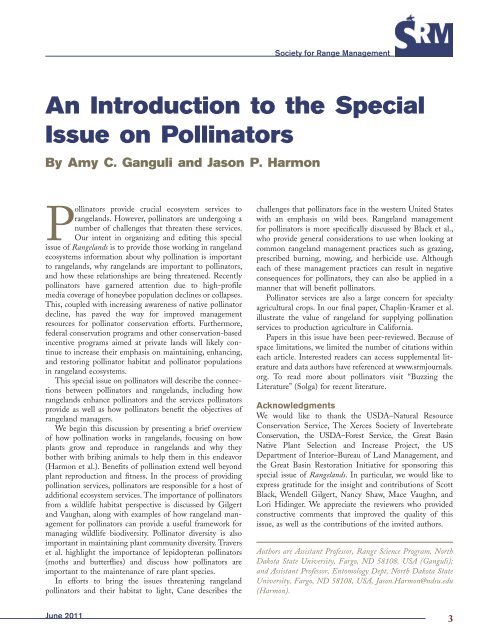Rangeland Magazine: Special Issue on Pollinators - The Xerces ...
Rangeland Magazine: Special Issue on Pollinators - The Xerces ...
Rangeland Magazine: Special Issue on Pollinators - The Xerces ...
Create successful ePaper yourself
Turn your PDF publications into a flip-book with our unique Google optimized e-Paper software.
Society for Range Management<br />
An Introducti<strong>on</strong> to the <str<strong>on</strong>g>Special</str<strong>on</strong>g><br />
<str<strong>on</strong>g>Issue</str<strong>on</strong>g> <strong>on</strong> <strong>Pollinators</strong><br />
By Amy C. Ganguli and Jas<strong>on</strong> P. Harm<strong>on</strong><br />
<strong>Pollinators</strong> provide crucial ecosystem services to<br />
rangelands. However, pollinators are undergoing a<br />
number of challenges that threaten these services.<br />
Our intent in organizing and editing this special<br />
issue of <str<strong>on</strong>g>Rangeland</str<strong>on</strong>g>s is to provide those working in rangeland<br />
ecosystems informati<strong>on</strong> about why pollinati<strong>on</strong> is important<br />
to rangelands, why rangelands are important to pollinators,<br />
and how these relati<strong>on</strong>ships are being threatened. Recently<br />
pollinators have garnered attenti<strong>on</strong> due to high-profile<br />
media coverage of h<strong>on</strong>eybee populati<strong>on</strong> declines or collapses.<br />
This, coupled with increasing awareness of native pollinator<br />
decline, has paved the way for improved management<br />
resources for pollinator c<strong>on</strong>servati<strong>on</strong> efforts. Furthermore,<br />
federal c<strong>on</strong>servati<strong>on</strong> programs and other c<strong>on</strong>servati<strong>on</strong>-based<br />
incentive programs aimed at private lands will likely c<strong>on</strong>tinue<br />
to increase their emphasis <strong>on</strong> maintaining, enhancing,<br />
and restoring pollinator habitat and pollinator populati<strong>on</strong>s<br />
in rangeland ecosystems.<br />
This special issue <strong>on</strong> pollinators will describe the c<strong>on</strong>necti<strong>on</strong>s<br />
between pollinators and rangelands, including how<br />
rangelands enhance pollinators and the services pollinators<br />
provide as well as how pollinators benefit the objectives of<br />
rangeland managers.<br />
We begin this discussi<strong>on</strong> by presenting a brief overview<br />
of how pollinati<strong>on</strong> works in rangelands, focusing <strong>on</strong> how<br />
plants grow and reproduce in rangelands and why they<br />
bother with bribing animals to help them in this endeavor<br />
(Harm<strong>on</strong> et al.). Benefits of pollinati<strong>on</strong> extend well bey<strong>on</strong>d<br />
plant reproducti<strong>on</strong> and fitness. In the process of providing<br />
pollinati<strong>on</strong> services, pollinators are resp<strong>on</strong>sible for a host of<br />
additi<strong>on</strong>al ecosystem services. <strong>The</strong> importance of pollinators<br />
from a wildlife habitat perspective is discussed by Gilgert<br />
and Vaughan, al<strong>on</strong>g with examples of how rangeland management<br />
for pollinators can provide a useful framework for<br />
managing wildlife biodiversity. Pollinator diversity is also<br />
important in maintaining plant community diversity. Travers<br />
et al. highlight the importance of lepidopteran pollinators<br />
(moths and butterflies) and discuss how pollinators are<br />
important to the maintenance of rare plant species.<br />
In efforts to bring the issues threatening rangeland<br />
pollinators and their habitat to light, Cane describes the<br />
challenges that pollinators face in the western United States<br />
with an emphasis <strong>on</strong> wild bees. <str<strong>on</strong>g>Rangeland</str<strong>on</strong>g> management<br />
for pollinators is more specifically discussed by Black et al.,<br />
who provide general c<strong>on</strong>siderati<strong>on</strong>s to use when looking at<br />
comm<strong>on</strong> rangeland management practices such as grazing,<br />
prescribed burning, mowing, and herbicide use. Although<br />
each of these management practices can result in negative<br />
c<strong>on</strong>sequences for pollinators, they can also be applied in a<br />
manner that will benefit pollinators.<br />
Pollinator services are also a large c<strong>on</strong>cern for specialty<br />
agricultural crops. In our final paper, Chaplin-Kramer et al.<br />
illustrate the value of rangeland for supplying pollinati<strong>on</strong><br />
services to producti<strong>on</strong> agriculture in California.<br />
Papers in this issue have been peer-reviewed. Because of<br />
space limitati<strong>on</strong>s, we limited the number of citati<strong>on</strong>s within<br />
each article. Interested readers can access supplemental literature<br />
and data authors have referenced at www.srmjournals.<br />
org. To read more about pollinators visit “Buzzing the<br />
Literature” (Solga) for recent literature.<br />
Acknowledgments<br />
We would like to thank the USDA–Natural Resource<br />
C<strong>on</strong>servati<strong>on</strong> Service, <strong>The</strong> <strong>Xerces</strong> Society of Invertebrate<br />
C<strong>on</strong>servati<strong>on</strong>, the USDA–Forest Service, the Great Basin<br />
Native Plant Selecti<strong>on</strong> and Increase Project, the US<br />
Department of Interior–Bureau of Land Management, and<br />
the Great Basin Restorati<strong>on</strong> Initiative for sp<strong>on</strong>soring this<br />
special issue of <str<strong>on</strong>g>Rangeland</str<strong>on</strong>g>s. In particular, we would like to<br />
express gratitude for the insight and c<strong>on</strong>tributi<strong>on</strong>s of Scott<br />
Black, Wendell Gilgert, Nancy Shaw, Mace Vaughn, and<br />
Lori Hidinger. We appreciate the reviewers who provided<br />
c<strong>on</strong>structive comments that improved the quality of this<br />
issue, as well as the c<strong>on</strong>tributi<strong>on</strong>s of the invited authors.<br />
Authors are Assistant Professor, Range Science Program, North<br />
Dakota State University, Fargo, ND 58108, USA (Ganguli);<br />
and Assistant Professor, Entomology Dept, North Dakota State<br />
University, Fargo, ND 58108, USA, Jas<strong>on</strong>.Harm<strong>on</strong>@ndsu.edu<br />
(Harm<strong>on</strong>).<br />
June 2011 3
















